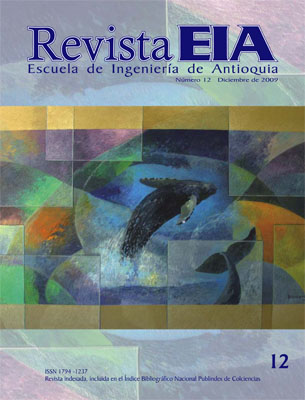DISEÑO Y CONSTRUCCIÓN DE UN SISTEMA PARA EXAMEN NO DESTRUCTIVO DE FALLAS Y DEFECTOS EN METALES UTILIZANDO SEÑALES ULTRASÓNICAS (DESIGN AND CONSTRUCTION OF A SYSTEM FOR NON-DESTRUCTIVE INSPECTION OF FAULTS AND DEFECTS IN METALS USING ULTRASONIC SIGNALS)
DISEÑO Y CONSTRUCCIÓN DE UN SISTEMA PARA EXAMEN NO DESTRUCTIVO DE FALLAS Y DEFECTOS EN METALES UTILIZANDO SEÑALES ULTRASÓNICAS (DESIGN AND CONSTRUCTION OF A SYSTEM FOR NON-DESTRUCTIVE INSPECTION OF FAULTS AND DEFECTS IN METALS USING ULTRASONIC SIGNALS)


This work is licensed under a Creative Commons Attribution-NonCommercial-NoDerivatives 4.0 International License.
Copyright statement
The authors exclusively assign to the Universidad EIA, with the power to assign to third parties, all the exploitation rights that derive from the works that are accepted for publication in the Revista EIA, as well as in any product derived from it and, in in particular, those of reproduction, distribution, public communication (including interactive making available) and transformation (including adaptation, modification and, where appropriate, translation), for all types of exploitation (by way of example and not limitation : in paper, electronic, online, computer or audiovisual format, as well as in any other format, even for promotional or advertising purposes and / or for the production of derivative products), for a worldwide territorial scope and for the entire duration of the rights provided for in the current published text of the Intellectual Property Law. This assignment will be made by the authors without the right to any type of remuneration or compensation.
Consequently, the author may not publish or disseminate the works that are selected for publication in the Revista EIA, neither totally nor partially, nor authorize their publication to third parties, without the prior express authorization, requested and granted in writing, from the Univeridad EIA.
Show authors biography
En el presente artículo se describe el diseño y construcción de un sistema electrónico para examen no destructivo con ultrasonido (ENDU), que es una de las técnicas más utilizadas para evaluar sin deteriorar piezas metalmecánicas en diversas áreas de la industria. Las técnicas de evaluación que se presentan en este trabajo son difracción de tiempo de vuelo (TOFD) y pulso-eco, para cuya prueba se incorporaron deliberadamente defectos en uniones metálicas soldadas (probetas). El sistema implementado consta de palpadores angulares dispuestos de acuerdo con la técnica que se utilizó en cada caso, un pulsador que alimenta adecuadamente a lospalpadores, los métodosde adquisición y procesamiento digital de la información. En el documento se incluyen gráficos A-Scan y D-Scan que ilustran un caso típico de análisis como ejemplo. Finalmente, se muestra que el sistema desarrollado demostró ser efectivo comparado con exámenes ejecutados con un equipo comercial de la misma naturaleza y con otra técnica de inspección como la radiográfica.
Abstract: The present paper describes the design and construction of an electronic system for non-destructive inspection with ultrasound (NDTU), which is one of the most used techniques to evaluate without deteriorating metallic parts in several areas of the industry. The evaluation techniques that appear in this document are Time of Flight Diffraction (TOFD) and pulse-echo, for which, defects in welded metallic unions were incorporated deliberately (test plates). The implemented system consists of two angular transducers according to the technique used in each case, a pulser that suitably feeds the transducer, the methodologies of acquisition and digital processing of the information. In the document, A-Scan and D-Scan graphs that illustrate a typical case of analysis as example are included. Finally, the developed system has demonstrated to be effective, compared with examinations made using a commercial equipment of the same nature, and with another technique of inspection like radiography.
Article visits 277 | PDF visits 184
